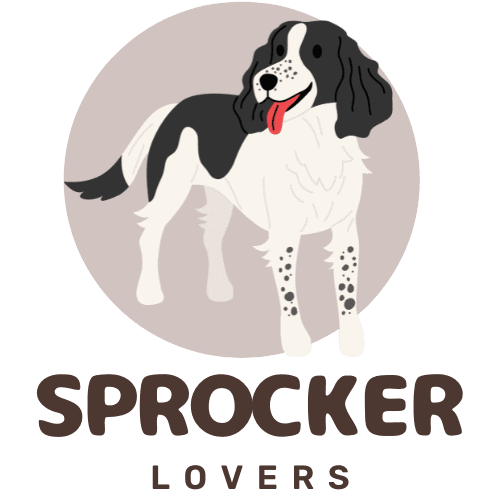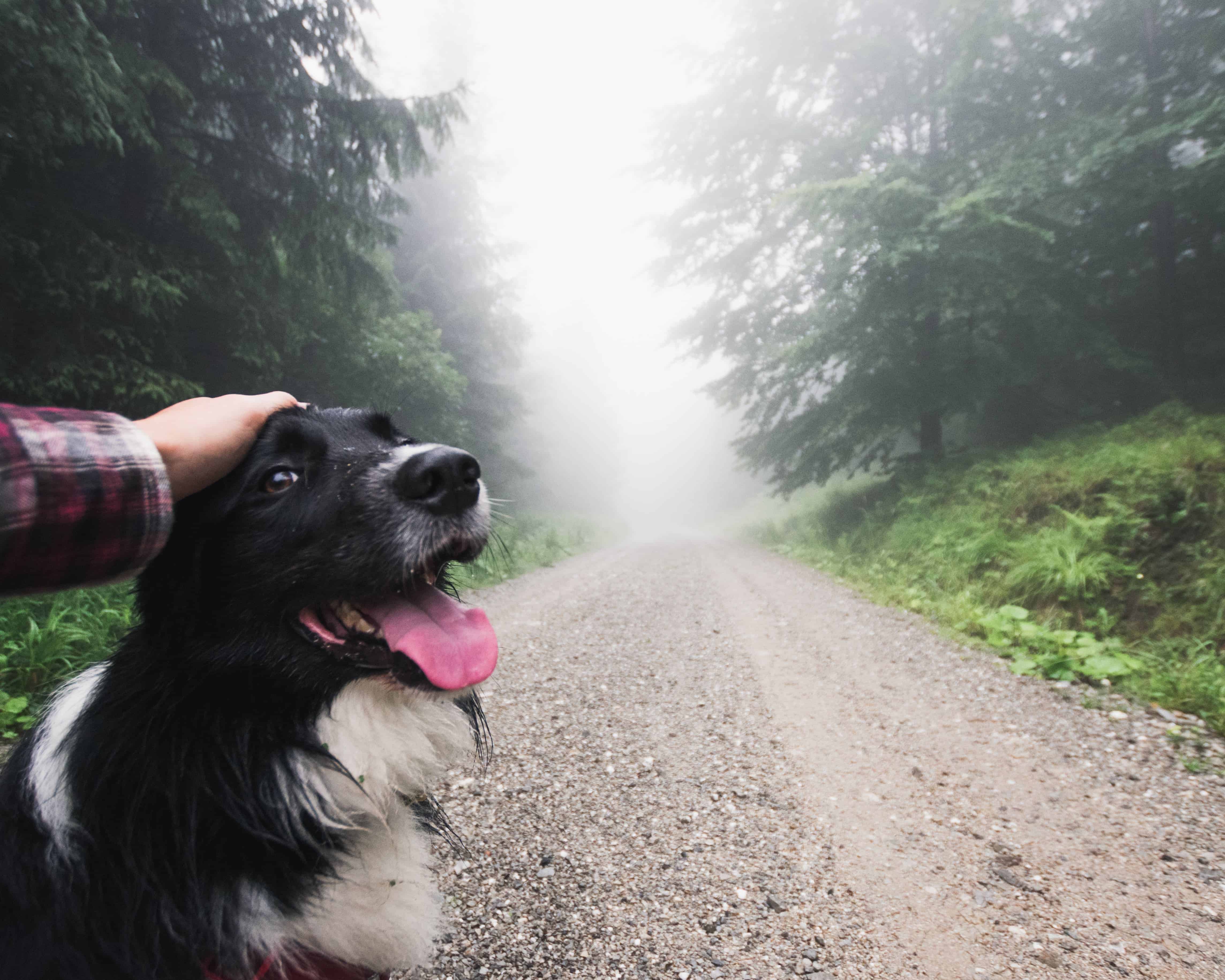Did you know that a little less than half dog owners in the UK walk their dog on a daily basis?
The same report found that people avoid walking their dogs for a variety of reasons, including:
- Their dog doesn’t like wet weather (20%)
- They wanted to avoid their pup getting dirty (4%)
- Owners were too tired, wanted to stay warm, or didn’t have enough time
This is bad news across the board.
This post contains affiliate links. Please read my full disclosure here.
Why is Dog Walking Important, Anyway?
Before we dive in with the dog walking tips you can use for a stress-free stroll, let’s iron out why dog walking is important.
The first reason: Your pup needs exercise. No matter their age or breed, all dogs need to move around–and limiting that movement to indoors or a small garden might not be enough for them to burn off steam. This could lead to them being destructive in the house.
Not only that, but walking your dog daily also socialises them to new things. They’ll be exposed to things you can’t see from their house, such as other dogs, cars, and people. (Remember: This kind of socialisation could prevent your dog from being fearful and/or aggressive to things they’re unfamiliar with later in life.)
Plus, walking your dog is a great way to spend quality time with them. You’re bound to build a bond with your pup if you’re taking them on a new adventure every day!
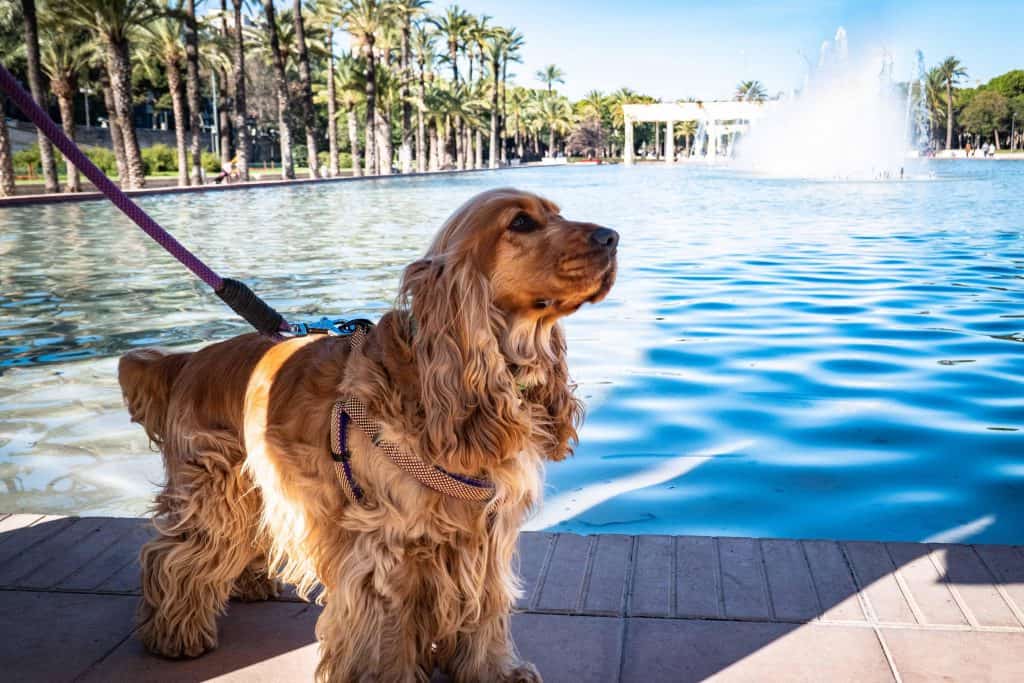
11 Dog Walking Tips to Follow for a Stress-Free Trip
Are you committed to walk your dog at least once a day?
(Bear in mind your dog might need much more exercise than this–especially if they’re a working dog, like one of the Spaniel breeds. They’re bred to work and need a lot of exercise to tire them out.)
You might be struggling to get into a routine with your dog walking, or give your pup an enjoyable walk.
Here are 11 awesome dog walking tips that make your walk less stressful:
- Pick a harness, collar, and lead
- Make sure they’re wearing an ID tag
- Train your pup to walk on a loose lead
- Master recall before going off-lead
- Expose your dog to new things
- Vary your route to prevent boredom
- Give your dog time to sniff around
- Stick to the 5 minutes per month rule
- Stay off polished gardens
- Bring plenty of water
- Plan for the weather
Click the links to jump to a specific tip, or continue scrolling to learn how you can take your dog on a stress-free walk.
1. Pick a harness, collar, and lead 🦴
There are tons of different lead options you can pick when walking your dog. Some work better than others for different uses:
Standard collar: The traditional way to walk a dog is by attaching their lead to a standard collar. However, this might be uncomfortable (and potentially dangerous) for a dog who is extremely energetic. You don’t want them to jet off in chase of a bird and hurt their neck when the lead stops.
Padded harness: A harness wraps around your pup’s torso which your lead attaches to. This is a more socially-acceptable way to walk your dog because it causes less harm to their neck. The only downside? Some dogs are encouraged to pull harder when they’re on a harness.
Figure of 8: If your dog pulls like a steam train when they’re being walked on a lead, it might be worth using this type of lead. A figure-8 lead wraps around your pup’s nose and discourages them from pulling. I use this for Hugo and it’s like walking a new dog:
Halti lead: Similar to a figure-8 lead, the halti is another lead that wraps around your pup’s nose to prevent them from pulling. It’s fully padded for comfort, and has enough flexibility to let them pant, eat or drink as normal.
Flexi-leads or standard leads: Retractable leashes cause many unnecessary hazards compared to traditional leashes. However, Flexi-leads are best reserved for walks in the park, when it’s safe for a dog to explore a bit further away.
Confused as to which you should start with? Here are two quick things to consider:
- The material it’s made from: Bear in mind that Nylon leashes are a good choice for the money conscious and are great for use in wet wintry conditions but Nylon leashes can cut into hands or give a pet parent “leash burn”.
- A suitable length and width: Pick a lead, collar, or harness that fits your dog’s strength, size, and weight. Most pet shops will do a free fitting to help you judge this.
You can use a mixture of these different leads and harnesses depending on the situation. For example: I walk Hugo with a harness on our daily walk, but if we’re going anywhere busy where I need more control over him (like the vets or a pet shop), I put his figure of 8 on to stop him pulling.
2. Make sure they’re wearing an ID tag 🏷
If you’re walking a dog in the UK, your dog needs to be microchipped. It’s the best way to make sure they’re returned to you if the worst happens. (Remember to update your information if you move house, too.)
Unfortunately, you can’t control everything that happens–and sometimes dogs get lost.
That’s why every time you leave the house with your beloved pup, you should make sure they’re wearing identification tags. It means your dog can be reunited with you if they’re found on the street, and don’t need taking to the vets to be scanned.

In fact, it’s also the law in the UK to have an ID tag on your dog’s collar (or harness) whenever they’re in public. It must include:
- Your surname
- Your postcode
- Your contact number
I also have the line “I am microchipped” in a larger font on Hugo’s ID tag just in case someone can’t read his tag clearly, or needs to verify that I am his owner.
3. Train your dog to walk on a loose lead 🚶♀️
There’s nothing worse than walking a dog that constantly tries to pull you over. I know the feeling with Hugo: when he was about six months old, he was a nightmare to walk. I dreaded walking him because I was convinced he was about to pull me over.
Luckily, there’s a great solution (or prevention tip!) for this: Training your dog to walk on a loose lead.
You can do this by:
- Filling your pockets with high-value treats
- Hold your lead in your left hand and position your dog on the right
- Give your pup a treat whenever they’re in that position and looking at you, using a command word. (I like to use “heal”)
- Once your dog is used to that position, start taking small steps forward
- Reward your dog with another treat when they stay in that position without tugging on their lead
- Gradually increase the number of steps you take before rewarding them
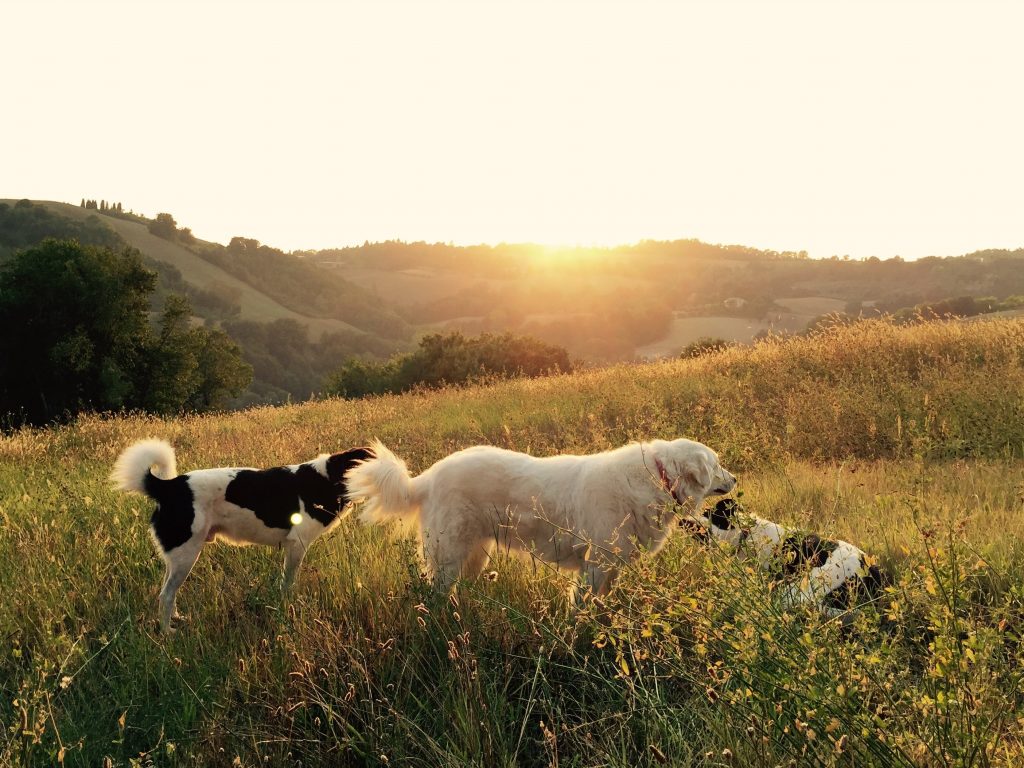
4. Practice recall before letting your dog off-lead 🐶
One of the proudest moments you will have when walking your dog is when they stop mid-sprint on the way to catch a bird, and come trotting back to you.
But letting your dog off their lead is terrifying–and advice on the best time to bite the bullet varies dramatically.
Some dog owners let their dog walk off-lead from their first walk, with the belief that their 10-week old puppy is too scared to ponder far away from you. You’re their security blanket at that age, and it might be harder to train them to come back to you when they get a taste of being free after a few months on a lead.
I didn’t follow that practice with Hugo. I was (and still am!) scared about giving him free reign when we’re on a walk, and make sure his recall is spot-on before he’s allowed off-lead.
Here’s a handy guide to help you work on your dog’s recall:
If you’re not at the 100% recall accuracy stage, I’d advise to keep them on-lead until they prove they can be trusted.
In the meantime, you could take them to a secure dog park. Or, you could walk them on a long-line lead which gives them some freedom–but also makes it easier to catch them if they decide to make a game out of coming back to be clipped onto their lead.
5. Expose your dog to new things on each walk 👩💼
Chances are, you’ve heard the word “socialisation” crop up when you’re buying a puppy.
Some people assume this means mixing your puppy with other dogs. But while that is part of socialisation, the idea behind it is that you want to help your puppy become acclimated to everything–like sights, sounds, and smells–in a positive way.
Proper socialisation can prevent a dog from being fearful of people and other animal and birds. It can also make them less likely to chase after these things, run away, or in the worst case: get hit by a car.
But it isn’t too late if your dog wasn’t socialised as a puppy. While the socialisation period is between 8 and 12 weeks, you can still work on those positive associations by exposing them to new things on each walk.
Here’s what that might look like, with a range of different things they might be exposed to at each place:
- Day 1, The vets: other dogs and cats, surgical smells
- Day 2, The woods: squirrels, off-lead dogs, trees
- Day 3, City centre: lots of different people, including men/women, babies, men, people in hats, and people in wheelchairs
- Day 4, A friend’s house: the scent of their house or their children
- Day 5, Main roads: cars, scooters, and cyclists
Most importantly, when introducing all of these new experiences to your puppy, make sure he’s getting an appropriate amount of treats and praise. The goal of socialisation is to make sure they associate what they’re being exposed to with positive praise–giving them a fun experience, and preventing anxieties about them later in life.
Bonus: Ready to kickstart your dog’s socialisation? Get a free printable checklist of places where you can socialise your puppy by heading this way!
6. Vary your route so your pooch doesn’t get bored 🐕
Like people, dogs can get bored if they’re walking the same route day-in, day-out. That’s why I’d recommend keeping your walk-time fresh and interesting by mixing it up a bit; changing your route every few days.
On the way, you’ll tick more things off your socialisation checklist. But even better? A new route means you can stop and talk to strangers who are also walking their dogs, and ask if your dogs can practice their greeting manners with a new friend.
You could also keep them interested in their daily walk by reversing your routine. Start off in the direction you normally finish, push on one street further, or explore brand new vicinity. It’s all fun for your pup.
The bottom line? New scenery keeps it interesting for you both. Predictable, when it comes to walks, is boring.
7. Give your dog time to sniff around 🐽
Going for a walk is one of the most exciting parts of your dog’s day. They spend all day indoors or playing in the garden–but you want to keep their nose at work… Especially if they’re a hunting dog, like a Sprocker.
Why not give them some more mental stimulation by letting them stop and sniff around when you’re on the walk? It’s true that walking is good physical exercise, but for your beloved dog it’s also about exploration.
Your dog identifies things by their smell, so varying your route exposes them to those new scents.
Remember: A 20-minute sniffing session could have the same impact as a 2-hour walk. You’d be surprised at how much more tired dogs are after a walk that includes exploration and sniffing, rather than just walking a straight line.
And while you may have walked down your road a million times now, but that certainly doesn’t mean there’s not new and exciting smells for your dog to check out every day.
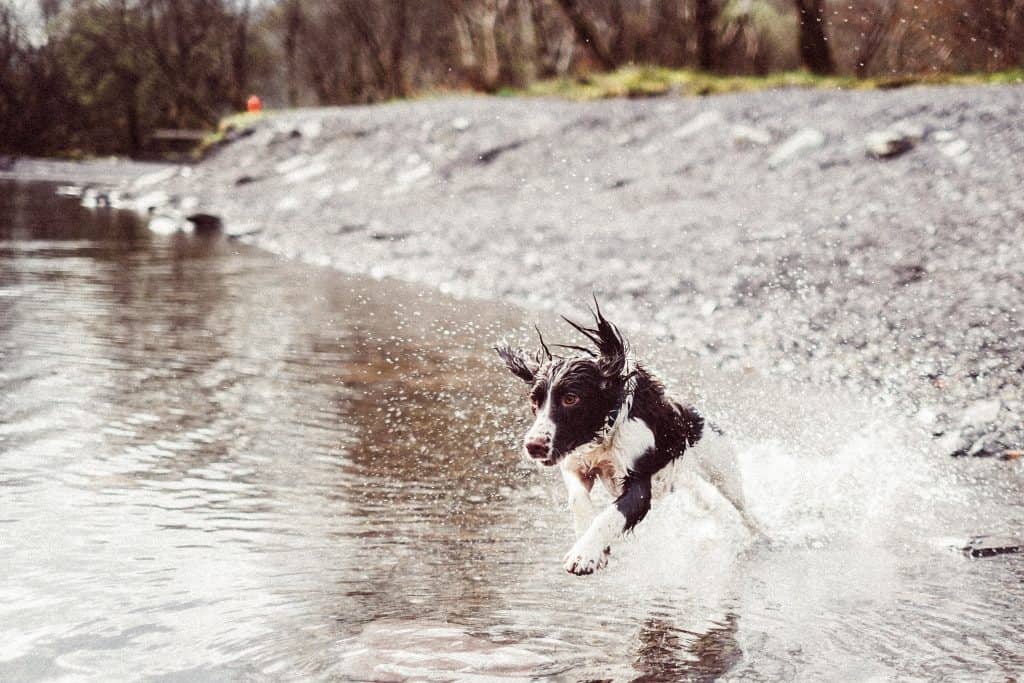
8. Stick to the “5 minutes per month” rule ⏳
Walking your puppy is an exciting thing. You want to make sure they’re being exposed to as many things as possible, and build a bond with your new dog.
However, it’s important that you know how far to walk them. Excessive walking can cause long-term joint damage for puppies, hence why they can’t be walked very far–no matter the breed.
The guideline for walking young dogs is five minutes per month, twice a day.
(For example: A three-month old puppy could have two 15-minute walks every day. A six-month old pup could handle two walks at 30 minutes each.)
It’s easy to go over that timeframe, but try to stick to it as closely as possible. Make a daily schedule of what time you’ll walk your dog, and the time you go on the walk so that your dog biological clock will be adjusted accordingly.
9. Stay off polished gardens 🏡
It’s tough to keep an excitable dog off pretty gardens. But it’s not just because they might ruin the lawn that you should deter them from walking on it.
It’s because the grass might have toxic lawn and garden products during the warmer months. Insecticides and certain types of mulch can cause problems for our furry friends-during walk. And while it’s not completely avoidable, you can cut down their chances of them falling ill by keeping them away from polished gardens.
What if your dog likes to stop and smell the flowers? Keep them on a short leash during your walks; even tulips and daffodils can cause significant stomach problems for our furry friends.
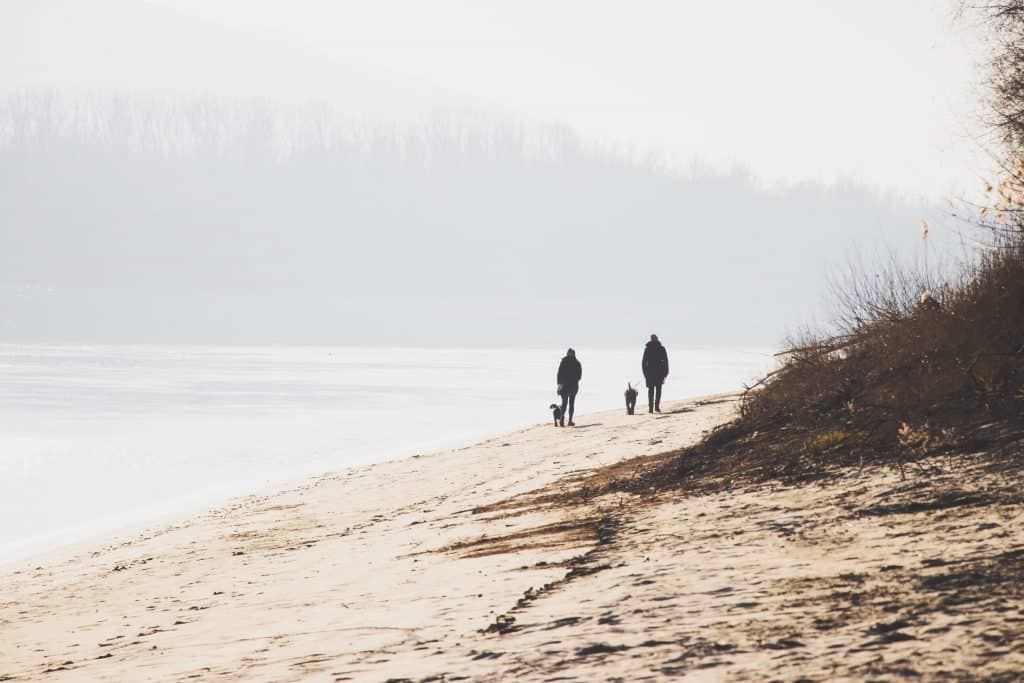
10. Bring plenty of water on your walk 🚰
Your dog will be dehydrated quickly after a walk, even when the weather isn’t hot. Can you blame them? They’re overstimulated, excited, and want to run around!
That’s why you should bring plenty of water along for your dog whenever you’re walking them. You can cup your hand to give them some water from a bottle, or use a bottle with a built-in tray to help them lap it up.
Plus, if your dog is extremely thirsty mid-walk, they might find places to grab a quick sip–be that a puddle or stream of dirty water. Both of those are full of bacteria. While a little splash likely won’t do much harm, it’s best to avoid huge gulps of stale water in favor of fresh drinking water.
11. Plan for the weather 🌦
Earlier, we touched on how the weather is a major thing that prevents dog owners from walking their pooch daily.
Unfortunately, there isn’t much you can control about the weather. You’ll have to suck it up and think of the benefits your dog gets from their daily walk. But there are some things that can make it easier to walk your dog in different weather.
In summer, avoid extremely hot concrete, asphalt pavement or sandy beaches. This can burn your dog’s paw. A good rule of thumb? If the walking surface is too hot for you to place your hand or bare foot on it for 5-10 seconds, then it’s too hot for your dog. You could also walk earlier in the morning or evening to avoid the hot sun.
There are boots for dogs that walk on really hot or really cold surfaces, too. These slip-on shoes also protect your dog from chemical irritation that may occur when walking on snowy or icy footpath.
12. Stay safe walking in the dark
Li-ran of Puppy Tip has a bonus dog walking tip: If you’re going to walk your dog at night, be sure to take the necessary safety precautions.
Wear a reflective jacket and put some reflective tape on the dog’s harness or collar.
You can also buy reflective harnesses and other gear, but tape is an easy and inexpensive alternative.
Additionally, walk on sidewalks instead of the street whenever possible, and always stick to well-lit areas or carry a flashlight to shine light in your path so neither of you step in anything unpleasant.
With Dog Walking, Practice Makes Perfect
When walking your dog, patience and consistency are key. Even little things matter, like using the same lead and walking on the same side of the road every time.
Regardless of how you’re walking your dog, it’s likely the most exciting part of their day. Make it yours, too–enjoy the time bonding and building trust with your furry friend.
